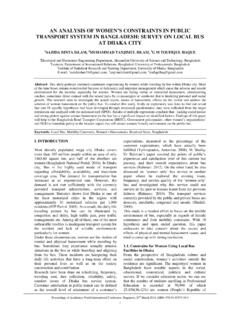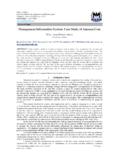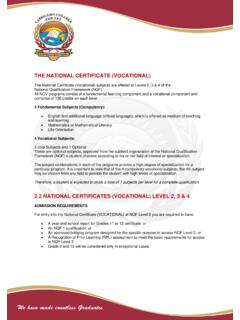Transcription of ROLE OF MANAGEMENT INFORMATION SYSTEM IN …
1 Proceedings of Academics World 18th International Conference, Boston, USA, 28th January 2016, ISBN: 978-81-925751-1-7 15 ROLE OF MANAGEMENT INFORMATION SYSTEM IN BUSINESS ORGANIZATIONS GERBI DAWIT YADETA Chongqing University of Posts and Telecommunications P. o. Box 400065 Chongqing, China Abstract The role of MANAGEMENT INFORMATION Systems is described in regarding of its capability for decision making. It is a computer SYSTEM that provides MANAGEMENT and other personnel within an organization with up-to-date INFORMATION regarding the organization's performance; for example, current inventory and sales. It usually is linked to a computer network, which is created by joining different computers together in order to share data and resources. MANAGEMENT INFORMATION SYSTEM (MIS) is basically concerned with processing INFORMATION which is then communicated to the various Departments in an organization appropriate decision-making.
2 With the growth of data and INFORMATION processing is related directly to the growth of the organizations which comprise society in general. So, it became important for the organization to manage or process its INFORMATION in better ways. MIS helps the organization to access its critical INFORMATION . MIS provides INFORMATION which is needed to manage organizations efficiently and effectively. MANAGEMENT INFORMATION systems are distinct from other INFORMATION systems because they are used to analyze operational activities in the organization Academically Organizations still need different types of various organizational levels, functions, and business processes. This needs opportunities and challenges. In this paper the role MANAGEMENT INFORMATION SYSTEM in Business Organizations will be given more elaboration. Keywords MIS, IS, IT, Organization. I. INTRODUCTION During the growth of a competitive global environment, there is considerable pressure on most organizations to make their operational, tactical, and strategic processes more efficient and effective.
3 An INFORMATION SYSTEM (IS) is a group of components which can increase competitiveness and gain better INFORMATION for decision making. Therefore various organizations have chosen to apply this group of components to their associations (Spalding, 1998). Consequently, the organizations decide to implement IS in order to improve the effectiveness and efficiency of the organizations. INFORMATION systems have become a major function area of business administration. The systems, nowadays, plays a vital role in the e-business and e-commerce operations, enterprise collaboration and MANAGEMENT , and strategic success of the business (Hevner et al., 2004). According to Ein-Dor and Segev (1978), an IS becomes a MANAGEMENT INFORMATION SYSTEM (MIS) when it is applied to improve MANAGEMENT by directors of the organization.
4 This SYSTEM can increase the performance of the MANAGEMENT . MIS is a collection of manpower s, tools, procedures and software to perform various business tasks at various levels in the organization (Tripathi, 2011). This SYSTEM has three basic levels: operational, middle MANAGEMENT and top MANAGEMENT where the INFORMATION is passed from bottom to top (Tripathi, 2011). Moreover, MIS is one of the important functions of MANAGEMENT which plays an important role in providing INFORMATION that is required for crucial decision making which directly affects the performance of the organization (Murthy, 2006). The addition of INFORMATION technology to the human resource industry has revolutionized the contemporary workplace. HR professionals now have an increased capacity not only to gather INFORMATION , but also to store and retrieve it in a timely and effective manner.
5 This has not only increased the efficiency of the organization but also the effectiveness of MANAGEMENT functions. The twenty-first century is characterized as the knowledge century (Chin-Loy and Mujtaba, 2007) II. CONCEPTS OF MANAGEMENT INFORMATION SYSTEM MIS has been understood and described in a number of ways. It is also popularly known as the INFORMATION SYSTEM , the INFORMATION and Decision SYSTEM , the Computer-based INFORMATION SYSTEM (Tripathi 2011). The MIS has more than one definition, some of which are given below: The MIS is defined as a SYSTEM which provides INFORMATION support for decision making in the organization. The MIS is defined as an integrated SYSTEM of man and machine for providing the INFORMATION to support the operations, the MANAGEMENT and the decision making function in the organization. The MIS is defined as a SYSTEM based on the database of the organization evolved for the purpose of providing INFORMATION to the people in the organization.
6 The MIS is defined as a Computer based INFORMATION SYSTEM . Role of MANAGEMENT INFORMATION SYSTEM in Business Organizations Proceedings of Academics World 18th International Conference, Boston, USA, 28th January 2016, ISBN: 978-81-925751-1-7 16 III. INFORMATION REQUIREMENTS FOR MODERN BUSINESS ORGANIZATIONS. INFORMATION SYSTEM produces INFORMATION to satisfy the needs of both the MANAGEMENT and operations subsystems, as well as the need of parties external to the organization. This INFORMATION reflects the internal activities of the organization, competitive actions, environmental and sociological interests and political and financial trends. It must represent what has happened, what is happening and perhaps most important of all, what will happen. This INFORMATION requirement exists with equal importance in private industry, educational institutions, governmental organizations and other organizations.
7 With the growth of data and INFORMATION processing is related directly to the growth of the organizations which comprise society in general. So, it became important for the organization to manage or process its INFORMATION in better ways. MIS helps the organization to access its critical INFORMATION (Wadhwa 2006). IV. OBJECTIVES OF MIS The followings are the objectives of the MIS To provide an overview of the INFORMATION requirements of organizations. To analyze the role of MANAGEMENT and its dependency on INFORMATION . To discuss the role of INFORMATION in the decision making process. To identify the need for INFORMATION in the day-to-day operations of the organization. V. ORGANIZATION PROCESSES AND STRUCTURES It is pertinent to mention at this juncture that the activities of the INFORMATION SYSTEM take place within the organizational structure and that the MIS seeks to serve the organization s objectives.
8 Therefore, it is important for INFORMATION specialists to have a working knowledge of what organizations are, their structures and factors which influence their methods and operations. There is no universally-accepted definition of an organization, but Kempner s (1976) is quite an interesting one. He states that an organization is a pattern of ways in which large numbers of people engage in a complexity of tasks, relate themselves to each other in the conscious, systematic establishment and accomplishment of mutually agreed purposes (Kempner, 1976). The formal organization is represented by the organizational chart and by official standards and procedures, while the informal organization is the social interaction between the members of the organization, their behavior and relationships and all the non-standard ways of conducting operations.
9 The development of effective MIS is dependent on recognition of the organization within an organization because the relationships depicted in formal organizational charts are not always the key relationships, and people have a way of altering standardized, official procedures: cutting through the red tape and beating the bureaucracy are phrases commonly used to describe this process. It is therefore important for INFORMATION systems designers to be aware of various influences on organizational design VI. TYPES OF INFORMATION MANAGEMENT SYSTEMS There are many types of INFORMATION MANAGEMENT systems in the market that provide a wide range of benefits for companies. Figure .1 Types of INFORMATION SYSTEM MANAGEMENT Systems Transaction processing systems (TPS) collect and record the day to day dealings of an organization.
10 This SYSTEM is mostly used at lower level of MANAGEMENT . MANAGEMENT INFORMATION systems (MIS) produce fixed, regularly scheduled reports based on data extracted and summarized from the firm s underlying transaction processing systems (TPS) helps to middle and operational level managers to provide answers to structured and semi structured decision problems. Decision-support systems (DSS) are mainly computer program applications used by middle MANAGEMENT to compile INFORMATION from a wide range of sources to solve problems and make decisions. These Role of MANAGEMENT INFORMATION SYSTEM in Business Organizations Proceedings of Academics World 18th International Conference, Boston, USA, 28th January 2016, ISBN: 978-81-925751-1-7 17 decisions are taken by top level MANAGEMENT executives. Executive support systems (ESS) is a reporting tool that provides quick access to summarized reports coming from all levels of organization and departments such as accounting, human resources and operations.











